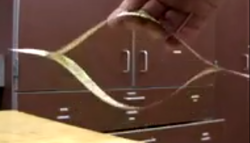Do you know how to make a telephone book fly?
One page at a time, of course!
Kids (and adults, as well) can have a great time learning about air flow, aerodynamics, creative paper engineering, and patience, with nothing more expensive or hard to acquire than an old phone book, a large piece of cardboard, a drinking straw or two, tape, and a pair of scissors. Oh, yeah, you’ll need a large room, as well.
The internet offers several different patterns that can be freely printed and used to make tumblewings, also known as walkalong gliders. Here are a few examples designed by the Science Toy Maker:



Others have taken his designs, which are freely shared online, and designed even more glider patterns.


The trick to making gliders that fly well is paying close attention to the pattern, and following it closely. If the vertical fins are not symmetrical, the glider will not fly straight, but will spiral. If the folds are accurate, the glider may dive or fall straight to the floor. If the design is not cut precisely, so that the glider’s wings are symmetrical, it won’t fly well. For some of the patterns, such as the jagwing and baby bug, precise cutting and folding is just the beginning. These two gliders require nose weights to fly properly. Getting just the right amount of weight in just the right place requires a bit of trial and error experimentation.



Since I was expecting a large age range to be represented at my program, I cut out and folded all the tumblewings beforehand. I cut out some Jagwings, as well. That way, we could get to the flying part of the program. In the past, having the participants make their own tumblewings took up a lot of time, and there were issues with imprecise scissors skills among younger participants.
To begin the program, I asked everyone what makes a kite fly. Then I asked them about others things that can fly – a hang glider, plane, rocket. We discussed how each was alike and how they are different. I had a box fan set up, and a mini kite I picked up at Dollar Tree. Turning the fan on, I placed the mini kite in front of it. We watched and discussed what happened as I changed the settings on the fan from medium to high to off.
By now, everyone in the program had a pretty good understanding of the of the aerodynamics involved in gliding on air currents. I picked up a tumblewing that had not been folded into shape, and asked everyone whether or not it could fly. Of course, when I released it, it just tumbled to the ground, like a bird’s feather. (I’ll have to have one on hand next time for comparison.) Most everyone in the room had predicted correctly. Then I picked it up and made the folds. I held it up again, and asked if it would fly this time. When I released it, it went tumbling across the room, just as it was supposed to do. We then discussed why it fly, and why it tumbles as it flies.
Then we got down to the fun part. Because of the size of the room, I was limited to allowing only three pilots at a time. I had the three line up at one end of the room with their gliders in one hand, and a large piece of cardboard in the other. They would launch their gliders one at a time, and try to pilot/drive them the length of the room, while everyone else cheered them on. Each person got three chances to fly a tumblewing, then we swapped out pilots for three more.
After everyone had flown a tumblewing, I got out the jagwings. I had attached nose weights to some of them, but not made the adjustments to get good flight to all of them. I showed the participants one that I had adjusted for correct flight. Then I tried one that had not been corrected for a good glide. I explained how these gliders needed a nose weight to make them fly properly. I demonstrated the process of fly, clip weight off of the nose, fly, clip a bit more off of the nose, fly, etc. We adjusted two jagwings, then everyone took turns trying to fly them in groups of three, just like before.
At the end of the program we discussed why we needed to use telephone book paper instead of other forms of paper. Then I explained to them how it has been discovered that very thin sheets of foam made gliders that fly even better than the ones made from the thin paper we were using. I promised them that by the next time I offer this program, I would have build a hot wire foam cutter, and would have foam gliders for them to try out and compare to the paper ones.
Everyone got a basic tumblewing of their own to take home and fly.
Here are some sites of interest that I used in preparing my tumblewings:
Welcome to Air Surfing (AKA Walk Along Gliding)
Walk Along Glider Made From Phone Book Paper
Here are some information on hot wire cutting to create even better tumblewing and walkalong gliders:




Leave A Comment